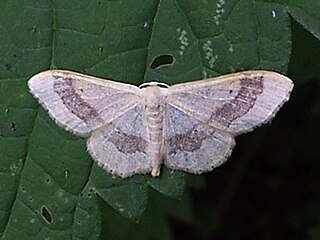
The riband wave is a moth of the family Geometridae. The species was first described by Carl Linnaeus in his 1758 10th edition of Systema Naturae.

Colostygia pectinataria, the green carpet, is a Palearctic moth of the genus Colostygia in the family Geometridae. It was first described by August Wilhelm Knoch in 1781.
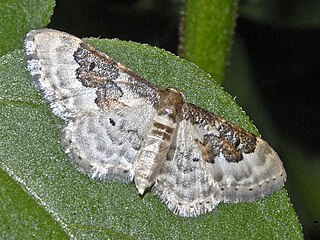
Idaea rusticata, the least carpet, is a moth of the family Geometridae. The species was first described by Michael Denis and Ignaz Schiffermüller in 1775.

Cepphis advenaria, the little thorn, is a moth of the family Geometridae. The species can be found in Europe and across the Palearctic to Japan.

Ecliptopera silaceata, the small phoenix, is a species of moth in the family Geometridae. The species was first described by Michael Denis and Ignaz Schiffermüller in 1775.

Ennomos alniaria, the canary-shouldered thorn, is a moth of the family Geometridae. The species was first described by Carl Linnaeus in his 1758 10th edition of Systema Naturae. It can be found in Europe in a wide variety of biotopes where there are deciduous trees, perhaps mostly in deciduous forests and gardens.

Ennomos autumnaria, the large thorn, is a moth of the family Geometridae. The species can be found in Western and Central Europe East to Russia and Siberia
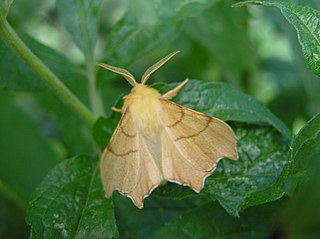
Ennomos erosaria, the September thorn, is a moth of the family Geometridae. The species can be found in the Palearctic realm in western Europe and from central Scandinavia. Its range extends to the northern Mediterranean and east to the Caucasus and Russia. It is widespread in mixed and deciduous forests in Europe. The south eastern occurrence reaches Turkey and the Caucasus. The main habitat is dry deciduous forests and parks. In the Southern Alps, the species rises to an altitude of about 1600 metres.

Epione repandaria, the bordered beauty, is a moth of the family Geometridae.

Hylaea fasciaria, the barred red, is a species of moth in the family Geometridae. The species can be found in central and northern Europe, the Urals, Caucasus, Altai and eastern Siberia.
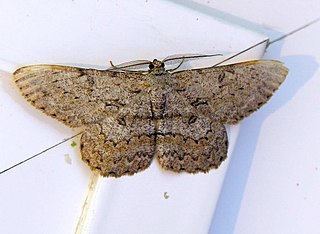
Hypomecis punctinalis, the pale oak beauty, is a moth of the family Geometridae. The species was first described by Giovanni Antonio Scopoli in his 1763 Entomologia Carniolica. The species can be found in central and southern Europe, Asia Minor, Transcaucasia, Russia, the Russian Far East, Japan, Korea, Ussuri and western China.

Macaria liturata, the tawny-barred angle, is a moth of the family Geometridae. It was first described by Carl Alexander Clerck in 1759 and it is found throughout Europe and across the Palearctic east to Japan.

Idaea fuscovenosa, the dwarf cream wave, is a moth of the family Geometridae. It is found in the Palearctic.

Ennomos fuscantaria, the dusky thorn, is a moth of the family Geometridae. The species can be found in the western part of the Palearctic realm in western Europe and from central Scandinavia its range extends to the northern Mediterranean and east to Russia.

Anticlea derivata, the streamer, is a moth of the family Geometridae. The species was first described by Michael Denis and Ignaz Schiffermüller in 1775. It is found in Europe, North Africa and across the Palearctic up to the Altai Mountains.It prefers to live on sunny slopes, hedge rows, bushy places as well as in gardens and parks.
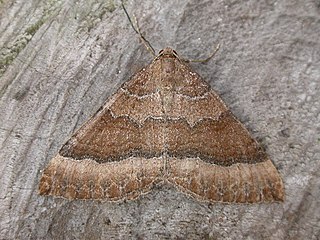
Larentia clavaria, the mallow, is a moth of the family Geometridae. The species was first described by Adrian Hardy Haworth in 1809. It is found from Siberia in the east to the Iberian Peninsula, North Africa, and the British Isles in the west. In the north it ranges to the Caucasus, Tajikistan and Fennoscandia. In the south it is found the western Mediterranean islands, Italy, the Balkans and Asia Minor. It occurs only locally and is almost always rare. In the Alps, it rises up to 1200 m above sea level.

Cyclophora puppillaria, or Blair's mocha, is a moth of the family Geometridae. The species was first described by Jacob Hübner in 1799. It can be found in Europe and from North Africa up to the Caucasus area.

Cleorodes is a monotypic moth genus in the family Geometridae described by Warren in 1894. Its single species, Cleorodes lichenaria, the Brussels lace, was first described by Johann Siegfried Hufnagel in 1767.

Colostygia olivata, the beech-green carpet, is a moth of the family Geometridae. It was first described by Michael Denis and Ignaz Schiffermüller in 1775 and it is found in most of the Palearctic.

Catarhoe basochesiata is a moth of the family Geometridae. It is found in Europe. It was first described by Philogène Duponchel in 1831 as Cidaria basochesiata. Catarhoe basochesiata has a wingspan of 23–27 mm (0.91–1.06 in). The forewings vary in colour from reddish brown to greyish brown, with some moths having very dark brown forewings that poorly contrast with the patterns on them. The moth can be found across the western Mediterranean, from the Iberian Peninsula across France and into Italy and from Morocco to Tunisia. The moth prefers hot, dry conditions in low coastal regions, from 0–500 m (0–1,640 ft) above sea level and occasionally higher.





















